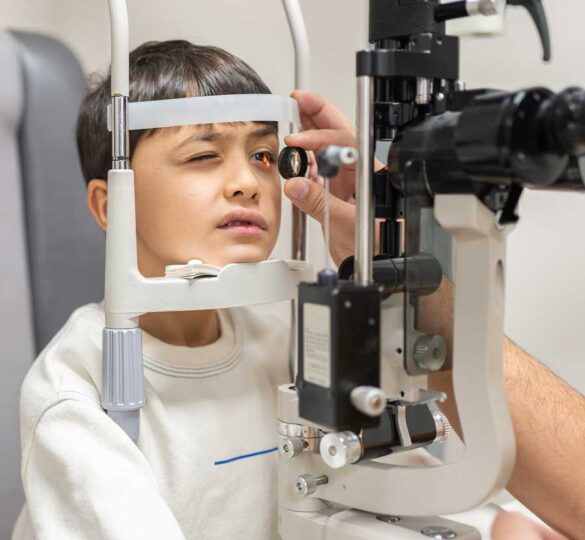Types of Pediatric Glaucoma

Glaucoma can affect people of all ages, including infants, children, and young people.
Many people think of glaucoma as a condition exclusively affecting older individuals. While it’s true that age is a significant risk factor for the disease, it can affect people of all ages, including infants, children, and young people. Although rare, pediatric glaucoma can lead to irreversible vision loss if not treated early.
According to the American Academy of Ophthalmology, a group of disorders known as pediatric glaucoma affects more than 300,000 children worldwide. Continue reading to learn about different types of pediatric glaucoma, its causes, symptoms, and treatment options.
Types of Pediatric Glaucoma
Primary Congenital Glaucoma
Also known as infantile or newborn glaucoma, primary congenital glaucoma(PCG) is a rare genetic eye disorder that affects infants and young children, typically within the first year of life. It’s characterized by elevated intraocular pressure (IOP), which can lead to optic nerve damage, visual impairment, and blindness if left untreated.
PCG occurs due to developmental abnormalities in the anterior segment of the eye, impairing the outflow of aqueous humor; the fluid responsible for maintaining IOP. Although the exact cause of PCG is not entirely understood, it’s believed to involve mutations in genes that regulate the development of the structures involved in aqueous humor outflow.
Juvenile Open-Angle Glaucoma
Juvenile open-angle glaucoma (JOAG) is a rare form of the disease that affects young individuals between age three and thirty-five. It’s a type of primary open-angle glaucoma, in which IOP is increased due to impaired drainage of aqueous humor from the eye. Like PCG, left untreated, it can lead to optic nerve damage and vision loss.
Researchers believe that JOAG is a genetically inherited condition, with mutations in the myocilin (MYOC) gene most commonly associated with the disease. The MYOC gene encodes the myocilin protein, which plays a role in the trabecular meshwork — the eye’s drainage system. When the drainage system is compromised, the aqueous humor cannot drain properly, leading to increased IOP.
Secondary Glaucoma
Secondary glaucoma results from complications from another medical condition or eye abnormality. There are several causes of secondary glaucoma, including eye injuries, inflammation, certain medications, and other underlying eye diseases. Like primary congenital and juvenile open-angle glaucoma, people with secondary glaucoma have increased IOP.
Symptoms of Pediatric Glaucoma
Various signs and symptoms may be associated with pediatric glaucoma. These include excessive tearing, light sensitivity, cornea cloudiness, eye enlargement, and vision loss. Because infants and young children may not be able to communicate their discomfort or vision problems, parents and caregivers should be aware of these signs and symptoms in children that would require prompt medical attention.
Treatment Options for Pediatric Glaucoma
Treatments for pediatric glaucoma depend on the type and severity of the condition. In most cases, the primary goal is to lower the IOP and prevent further eye damage. Treatment options may include:
Medication
Eye drops and oral medications can be used to reduce IOP by either decreasing the production of aqueous humor or increasing its outflow. Commonly used medications include prostaglandin analogs, beta-blockers, alpha-agonists, and carbonic anhydrase inhibitors.
Surgery
Surgery is usually the initial treatment for childhood glaucoma. Surgical interventions may also be used when medications alone are insufficient to control IOP. Surgery options can include:
- Goniotomy and Trabeculotomy — Both of these procedures are done to enhance aqueous humor drainage by removing part of the trabecular meshwork. These procedures also open the inner wall of Schlemm’s canal.
- Trabeculectomy — A trabeculectomy creates an opening in the sclera that allows aqueous humor to exit the eye.
- Glaucoma Drainage Devices — Glaucoma drainage devices (GDDs) or tube shunts, are implanted in the eye to create a new pathway for the drainage of aqueous humor to lower IOP.
Monitoring & Follow-Up Care
Regular follow-up visits with a pediatric ophthalmologist or glaucoma specialist are crucial to monitor a child’s IOP, optic nerve, and visual field to ensure effective treatment.
Help Us Provide Hope
With early diagnosis, treatment, and careful monitoring, pediatric glaucoma can be successfully treated, preventing it from causing permanent and significant vision impairment. Parents and caregivers can access information about pediatric glaucoma to ensure they’re taking the best course of action to help their child diagnosed with glaucoma.
Your support can help dedicated researchers continue to discover the causes and cures for glaucoma. Your donations give hope to those living with glaucoma and accelerate our search for a cure.
Posted May 17, 2023. This article was reviewed for medical accuracy by Angelo P. Tanna, MD.

Angelo P. Tanna, MD
Angelo P. Tanna, MD is Vice Chairman and Professor of Ophthalmology, and Director of the Glaucoma Service at the Northwestern University Feinberg School of Medicine in Chicago, IL.